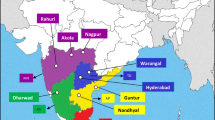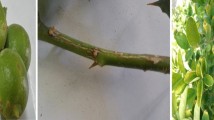Abstract
Severe Verticillium wilt of cotton in southern Spain is associated with the spread of a highly virulent, defoliating (D) pathotype of Verticillium dahliae. Eleven of the D and 15 of a mildly virulent, nondefoliating (ND) pathotype were analyzed by random amplified polymorphic DNA (RAPD) using the polymerase chain reaction (PCR). Six of 21 primers tested generated pathotype-associated RAPD bands. Another 21 V. dahliae isolates were compared in blind trials both by RAPD-PCR using the six selected primers and pathogenicity tests on cotton cultivars. There was a 100% correlation between pathotype characterization by each method. Unweighted paired group method with arithmetic averages cluster analysis was used to divide the 47 V. dahliae isolates into two clusters that correlated with the D or ND pathotypes. There was more diversity among ND isolates than among D isolates, these latter isolates being almost identical. ND- and D-associated RAPD bands of 2.0 and 1.0 kb, respectively, were cloned, sequenced, and used to design specific primers for the D and ND pathotypes. These pathotype-associated RAPD bands were present only in the genome of the pathotype from which they were amplified, as shown by Southern hybridization. The specific primers amplified only one DNA band of the expected size, and in the correct pathotype, when used for PCR with high annealing temperature. These specific primers successfully characterized V. dahliae cotton isolates from China and California as to D or ND pathotypes, thus demonstrating the validity and wide applicability of the results.
Similar content being viewed by others
References
Anonymous (1998) Boletín de Información Agraria y Pesquera 127. Consejería de Agricultura y Pesca, Junta de Andalucía, Sevilla, Spain
Assigbetse BK, Fernandez D, Dubois MP and Geiger JP (1994) Differentiation of Fusarium oxysporum f.sp. vasinfectum races on cotton by random amplified polymorphic DNA (RAPD) analysis. Phytopathology 84: 622–626
Balardin RS, Jarosz AM and Kelly JD (1997) Virulence and molecular diversity in Colletotrichum lindemuthianum from South, Central and North America. Phytopathology 87: 1184–1191
Barbara DJ, Paplomatas EJ and Jiménez-Díaz RM (1998) Variability in V. dahliae. In: Hiemstra JA and Harris DC (eds) A Compendium of VerticilliumWilts in Tree Species (pp 43–45) Ponsen & Looijen, Wageningen
Bejarano-Alcázar J, Melero-Vara JM, Blanco-López MA and Jiménez-Díaz RM (1995) Influence of inoculum density of defoliating and nondefoliating pathotypes of Verticillium dahliae on epidemics of Verticillium wilt of cotton in southern Spain. Phytopathology 85: 1474–1481
Bejarano-Alcázar J, Blanco-López MA, Melero-Vara JM and Jiménez-Díaz RM (1996) Etiology, importance, and distribution of Verticillium wilt of cotton in southern Spain. Plant Dis 80: 1233–1238
Bejarano-Alcázar J, Blanco-López MA, Melero-Vara JM and Jiménez-Díaz RM (1997) The influence of Verticillium wilt epidemics on cotton yield in southern Spain. Plant Pathol 46: 168–178
Bell AA (1992) Verticillium wilt. In: Hillocks RJ (ed) Cotton Diseases (pp 87–126) C.A.B. International, Oxon
Bell AA (1994) Mechanisms of disease resistance in Gossypium species and variation in Verticillium dahliae. In: Constable GA and Forrester NW (eds) Challenging the Future: Proc World Cotton Res Conf-1 (pp 225–235) CSIRO, Melbourne
Carder JH and Barbara DJ (1991) Molecular variation and restriction fragment length polymorphisms (RFLPs) within and between six species of Verticillium. Mycol Res 95: 935–942
Carder JH and Barbara DJ (1994) Molecular variation within some Japanese isolates of Verticillium dahliae. Plant Pathol 43: 947–950
Cotton JR, Presley JT and Darvish F (1969) Distribution of Verticillium wilt in cotton-growing areas of the U.S. Plant Dis Rep 53: 116–117
Devereux J, Haeberli P and Smithies O (1984) A comprehensive set of sequence analysis programs for the Vax. Nucleic Acid Res 12: 387–395
García-Pedrajas MD, Bainbridge BW, Heale JB, Pérez-Artés E and Jiménez-Díaz RM (1999) A simple PCR-based method for the detection of the chickpea wilt pathogen Fusarium oxysporum f.sp. ciceris in artificial and natural soils. Eur J Plant Pathol 105: 251–259
Henson JM and French R (1993) The polymerase chain reaction and plant disease diagnosis. Annu Rev Phytopathol 31: 81–109
Joaquim TR and Rowe RC (1990) Reassessment of vegetative compatibility relationships among strains of Verticillium dahliae using nitrate-nonutilizing mutants. Phytopathology 50: 1160–1166
Kelly AG, Alcalá-Jiménez AR, Bainbridge BW, Heale JB, Pérez-Artés E and Jiménez-Díaz RM (1994) Use of genetic fingerprinting and random amplified polymorphic DNA to characterize pathotypes of Fusarium oxysporum f.sp. ciceris infecting chickpea. Phytopathology 84: 1293–1298
Kelly AG, Bainbridge BW, Heale JB, Pérez-Artés E and Jiménez-Díaz RM (1998) In planta-polymerase-chain-reaction detection of the wilt-inducing pathotype of Fusarium oxysporum f.sp. ciceris in chickpea (Cicer arietium L.). Physiol Mol Plant Pathol 52: 397–409
Koike M, Fujita M, Nagao H and Ohshima S (1996) Random amplified polymorphic DNA analysis of Japanese isolates of Verticillium dahliae and V. albo-atrum. Plant Dis 80: 1224–1227
Korolev N, Jiménez-Díaz RM, Katan J and Katan T (1998) Vegetative compatibility and pathogenicity of Verticillium dahliae cotton isolates from Spain and Israel. Phytoparasitica 26: 2.
Mathre DE, Erwin DC, Paulus AD and Ravenscroft AV (1966) Comparison of the virulence of isolates of Verticillium alboatrum from several of the cotton-growing regions in the United States, Mexico and Peru. Plant Dis Rep 50: 930–933
McDermott MJ, Brändle U, Dutly F, Haemmerli AU, Keller S, M¨uller EK and Wolf SM (1994) Genetic variation in powdery mildew of barley: development of RAPD, SCAR, and VNTR markers. Phytopathology 84: 1316–1321
Messner R, Schweigkofler W, Ibl M, Berg G and Prillinger H (1996) Molecular characterization of the plant pathogen Verticillium dahliae Kleb. using RAPD-PCR and sequencing of the 18s rRNA gene. J Phytopathol 144: 347–354
Morton A, Carder JH and Barbara DJ (1995) Sequences of the internal transcribed spacers of the ribosomal RNA genes and relationships between isolates of Verticillium albo-atrum and V. dahliae. Plant Pathol 44: 183–190
Nazar RN, Hu X, Schmidt J, Culham D and Robb J (1991) Potential use of PCR-mediated ribosomal intergenic sequences in the detection and differentiation ofVerticillium wilt pathogens. Physiol Mol Plant Pathol 39: 1–11
Okoli CAN, Carder JH and Barbara DJ (1993) Molecular variation and sub-species grouping within Verticillium dahliae. Mycol Res 97: 233–239
Okoli CAN, Carder JH and Barbara DJ (1994) Restriction fragment length polymorphisms (RFLPs) and the relationships of some host-adapted isolates of Verticillium dahliae. Plant Pathol 43: 33–40
Presley JT (1969) Growth response of Verticillium albo-atrum to sanguinarine in nutrient agar. Phytopathology 59: 1968–1969
Puhalla JE and Hummel M (1983) Vegetative compatibility groups within Verticillium dahliae. Phytopathology 73: 1305–1308
Raeder U and Broda P (1985) Rapid preparation of DNA from filamentous fungi. Lett Appl Microbiol 1: 17–20
Ramsay JR, Multani DS and Lyon BR (1996) RAPD-PCR identification of Verticillium dahliae isolates with differential pathogenicity to cotton. Aust J Agric Res 47: 681–693
Rohlf JF (1988) NTSYS-pc: numerical taxonomy and multivariate analysis system. Version 1.80. Exeter Software. Setauket, NY
Rodríguez-Jurado D, Blanco-López MA, Rapoport HF and Jiménez-Díaz RM (1993) Present status of Verticillium wilt of olive in Andalucía (southern Spain). Bull OEPP/EPPO Bull 23: 513–516
Sambrook J, Fritsch EF and Maniatis T (1989) Molecular Cloning: A Laboratory Manual. 2nd edn. Cold Spring Harbor Laboratory, Cold Spring Harbor, NY.
Schnathorst WC (1969) A severe form of Verticillium albo-atrum in Gossypium barbadense in Peru. Plant Dis Rep 53: 149–150
Schnathorst WC (1973) Additional strains of Verticillium dahliae from cotton in California. In: Conf National Cotton Council of America, Proc Beltwide Cotton Prod Res (pp 22–23) Memphis, TN
Schnathorst WC and Mathre DE (1966). Host range and differentiation of a severe form of Verticillium albo-atrum in cotton. Phytopathology 56: 1155–1161
Schnathorst WC and Sibbet GS (1971) The relation of strains of Verticillium albo-atrum to severity of Verticillium wilt in Gossypium hirsutum and Olea europaea in California. Plant Dis Rep 9: 780–782
Sneath P and Sokal R (1973) Numerical Taxonomy: the Principles and Practice of Numerical Classification. W.H. Freeman and Co., San Francisco, CA
Typas MA, Griffen AM, Bainbridge BW and Heale JB (1992) Restriction fragment length polymorphisms in mitochondrial DNA and ribosomal RNA gene complexes as an aid to the characterization of species and sub-species populations in the genus Verticillium. FEMS Microbiol Lett 95: 157–162
Williams KGJ, Kubelik AR, Livak JK, Rafalski JA and Tingey SV (1990) DNA polymorphisms amplified by arbitrary primers are useful as genetic markers. Nucleic Acid Res 18: 6531–6535
Zhengjun X, Achar NP and Benkang G (1998) Vegetative compatibility groupings of Verticillum dahliae from cotton in mainland China. Eur J Plant Pathol 104: 871–876
Author information
Authors and Affiliations
Rights and permissions
About this article
Cite this article
Pérez-Artés, E., García-Pedrajas, M.D., Bejarano-Alcázar, J. et al. Differentiation of Cotton-defoliating and Nondefoliating Pathotypes of Verticillium dahliae by RAPD and Specific PCR Analyses. European Journal of Plant Pathology 106, 507–517 (2000). https://doi.org/10.1023/A:1008756307969
Issue Date:
DOI: https://doi.org/10.1023/A:1008756307969




